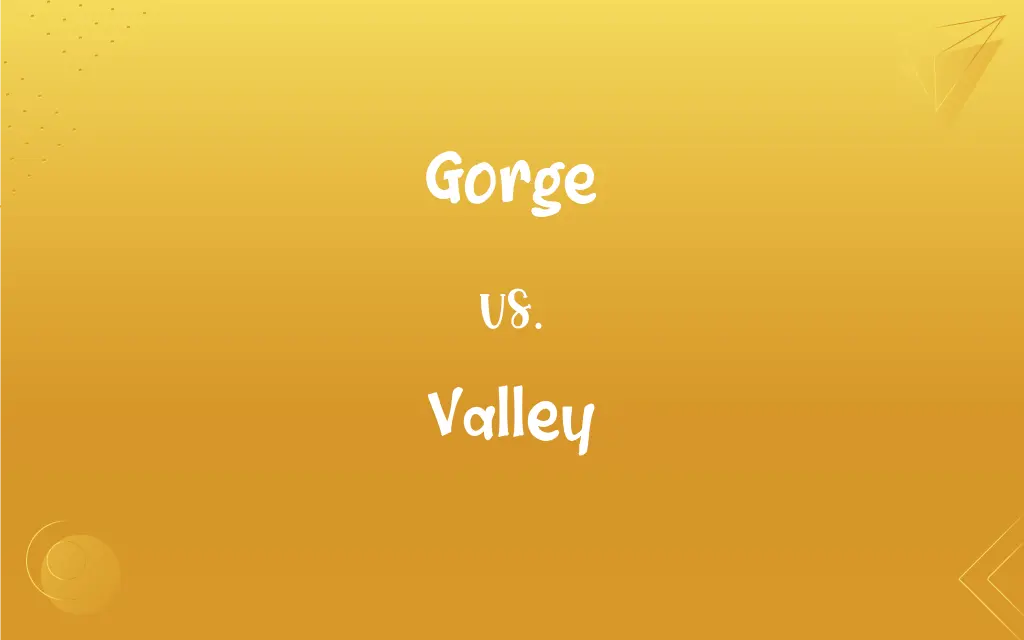Gorge vs. Valley: What's the Difference?
By Aimie Carlson & Harlon Moss || Updated on May 22, 2024
A gorge is a narrow, steep-sided valley often formed by river erosion, whereas a valley is a broad, flat-bottomed landform between hills or mountains, formed by various geological processes.

Key Differences
A gorge is a narrow, steep-sided valley that is typically formed by the powerful erosion of a river over a long period. These landforms are characterized by their vertical or near-vertical walls, creating a dramatic and rugged appearance. On the other hand, a valley is a broader, more gently sloping landform that can be formed through various geological processes, including river erosion, glacial activity, or tectonic movements. Valleys generally have wider floors and are more open compared to gorges, making them suitable for human habitation and agriculture.
Gorges are less common than valleys and tend to be more dramatic and scenic due to their steep sides and narrow confines. They are often found in mountainous or hilly regions where river flow is rapid and forceful. In contrast, valleys are more widespread and come in various forms and sizes. They are found in different environments, from mountainous regions to plains. Valleys provide fertile grounds for agriculture, settlements, and transportation routes due to their relatively flat and open nature.
While gorges are often formed solely by the erosive power of rivers, valleys can result from a combination of geological processes. This diversity in formation leads to a variety of valley types and landscapes, each with unique characteristics and ecosystems. The accessibility and fertility of valleys have historically made them crucial for human civilization.
Comparison Chart
Definition
Narrow, steep-sided valley formed by river erosion
Broad, flat-bottomed landform between hills/mountains
Formation Process
Erosion by a river
Erosion, glacial activity, or tectonic movements
ADVERTISEMENT
Appearance
Steep walls, narrow width
Wide floor, gentle slopes
Common Locations
Mountainous or hilly regions
Various environments, including plains
Human Use
Less suitable for habitation
Suitable for agriculture and settlements
Gorge and Valley Definitions
Gorge
A deep, narrow ravine.
The gorge was difficult to traverse due to its steep sides.
Valley
A region of low land.
The village nestled in the quiet valley.
ADVERTISEMENT
Gorge
A rugged canyon formed by water erosion.
The river flowed swiftly through the narrow gorge.
Valley
A low area between hills or mountains.
The farmers cultivated crops in the fertile valley.
Gorge
A deep narrow valley with steep rocky sides; a ravine.
Valley
A depression in the Earth's surface.
The valley stretched for miles, offering a scenic view.
Gorge
A narrow entrance into the outwork of a fortification.
Valley
A broad, flat-bottomed landform.
The valley was surrounded by gently rolling hills.
Gorge
The throat; the gullet
The gory sight made my gorge rise.
Valley
An elongated lowland between ranges of mountains, hills, or other uplands, often having a river or stream running along the bottom.
Gorge
The crop of a hawk.
Valley
An extensive area of land drained or irrigated by a river system.
Gorge
An instance of gluttonous eating.
Valley
A depression or hollow resembling or suggesting a valley, as the point at which the two slopes of a roof meet.
Gorge
The contents of the stomach; something swallowed.
Valley
An elongated depression cast between hills or mountains, often garnished with a river flowing through it.
Gorge
A mass obstructing a narrow passage
A shipping lane blocked by an ice gorge.
Valley
An area which drains itself into a river.
Gorge
The seam on the front of a coat or jacket where the lapel and the collar are joined.
Valley
Any structure resembling one, e.g. the interior angle formed by the intersection of two sloping roof planes.
Gorge
To stuff with food; glut
Gorged themselves with candy.
Valley
To form the shape of a valley.
Gorge
To devour greedily.
Valley
The space inclosed between ranges of hills or mountains; the strip of land at the bottom of the depressions intersecting a country, including usually the bed of a stream, with frequently broad alluvial plains on one or both sides of the stream. Also used figuratively.
The valley of the shadow of death.
Sweet interchangeOf hill and valley, rivers, woods, and plains.
Gorge
To eat gluttonously.
Valley
The place of meeting of two slopes of a roof, which have their plates running in different directions, and form on the plan a reëntrant angle.
Gorge
(archaic) The front aspect of the neck; the outside of the throat.
Valley
A long depression in the surface of the land that usually contains a river
Gorge
The inside of the throat; the esophagus, the gullet; the crop or gizzard of a hawk.
Valley
A long, narrow plain.
The river meandered through the wide valley.
Gorge
Food that has been taken into the gullet or the stomach, particularly if it is regurgitated or vomited out.
Gorge
(US) A choking or filling of a channel or passage by an obstruction; the obstruction itself.
An ice gorge in a river
Gorge
(architectural element) A concave moulding; a cavetto.
Gorge
The rearward side of an outwork, a bastion, or a fort, often open, or not protected against artillery; a narrow entry passage into the outwork of an enclosed fortification.
Gorge
(fishing) A primitive device used instead of a hook to catch fish, consisting of an object that is easy to swallow but difficult to eject or loosen, such as a piece of bone or stone pointed at each end and attached in the middle to a line.
Gorge
(geography) A deep, narrow passage with steep, rocky sides, particularly one with a stream running through it; a ravine.
Gorge
(mechanical engineering) The groove of a pulley.
Gorge
An act of gorging.
Gorge
To stuff the gorge or gullet with food; to eat greedily and in large quantities. on
They gorged themselves on chocolate and cake.
Gorge
(transitive) To swallow, especially with greediness, or in large mouthfuls or quantities.
Gorge
(transitive) To fill up to the throat; to glut, to satiate.
Gorge
(transitive) To fill up (an organ, a vein, etc.); to block up or obstruct; of ice: to choke or fill a channel or passage, causing an obstruction.
Gorge
(slang) Gorgeous.
Oh, look at him: isn’t he gorge?
Gorge
The throat; the gullet; the canal by which food passes to the stomach.
Wherewith he gripped her gorge with so great pain.
Now, how abhorred! . . . my gorge rises at it.
Gorge
A narrow passage or entrance
Gorge
That which is gorged or swallowed, especially by a hawk or other fowl.
And all the way, most like a brutish beast,e spewed up his gorge, that all did him detest.
Gorge
A filling or choking of a passage or channel by an obstruction; as, an ice gorge in a river.
Gorge
A concave molding; a cavetto.
Gorge
The groove of a pulley.
Gorge
A primitive device used instead of a fishhook, consisting of an object easy to be swallowed but difficult to be ejected or loosened, as a piece of bone or stone pointed at each end and attached in the middle to a line.
Gorge
To swallow; especially, to swallow with greediness, or in large mouthfuls or quantities.
The fish has gorged the hook.
Gorge
To glut; to fill up to the throat; to satiate.
The giant gorged with flesh.
Gorge with my blood thy barbarous appetite.
Gorge
To eat greedily and to satiety.
Gorge
A deep ravine (usually with a river running through it)
Gorge
A narrow pass (especially one between mountains)
Gorge
The passage between the pharynx and the stomach
Gorge
Overeat or eat immodestly; make a pig of oneself;
She stuffed herself at the dinner
The kids binged on icecream
Gorge
A narrow valley with steep, rocky walls.
The hikers explored the deep gorge carved by the river.
Gorge
A chasm with a stream running through it.
They admired the beauty of the gorge from the lookout point.
Gorge
A steep-sided valley.
The gorge provided a dramatic backdrop for the landscape.
FAQs
What geological processes form valleys?
Valleys can be formed by river erosion, glacial activity, or tectonic movements.
Can a gorge be found in flat areas?
No, gorges are typically found in mountainous or hilly regions.
What are some examples of famous gorges?
The Grand Canyon in the USA and the Iron Gates along the Danube River.
What is the main feature of a gorge?
The main feature of a gorge is its steep, rocky walls.
How does river erosion create gorges?
River erosion creates gorges by cutting deep, narrow channels through resistant rock layers over time.
What is a gorge?
A gorge is a narrow, steep-sided valley formed primarily by river erosion.
How is a valley different from a gorge?
A valley is broader and has gentler slopes, whereas a gorge is narrow with steep, vertical sides.
Can glaciers form valleys?
Yes, glaciers can carve out U-shaped valleys during their movement.
Are valleys suitable for agriculture?
Yes, valleys often have fertile soil and are suitable for agriculture.
Can people live in gorges?
Gorges are generally less suitable for habitation due to their steep sides and narrow width.
Are valleys more common than gorges?
Yes, valleys are more common and found in various environments.
What is the typical shape of a gorge?
Gorges are typically narrow and deep with steep, vertical walls.
What role do rivers play in the formation of valleys?
Rivers can carve out valleys through erosion over long periods.
What makes valleys fertile?
Valleys often have rich alluvial soil deposited by rivers, making them fertile.
What is a V-shaped valley?
A V-shaped valley is formed by river erosion and has a pointed, narrow bottom.
What is the significance of valleys in human history?
Valleys have been crucial for agriculture, settlements, and transportation routes.
Can gorges be tourist attractions?
Yes, gorges are often scenic and attract tourists for their dramatic landscapes.
What is an example of a valley formed by tectonic movements?
The Great Rift Valley in East Africa is formed by tectonic movements.
What is a U-shaped valley?
A U-shaped valley is formed by glacial activity, characterized by a flat floor and steep sides.
Are valleys important for ecosystems?
Yes, valleys support diverse ecosystems due to their varied landscapes and water sources.
About Author
Written by
Aimie CarlsonAimie Carlson, holding a master's degree in English literature, is a fervent English language enthusiast. She lends her writing talents to Difference Wiki, a prominent website that specializes in comparisons, offering readers insightful analyses that both captivate and inform.
Co-written by
Harlon MossHarlon is a seasoned quality moderator and accomplished content writer for Difference Wiki. An alumnus of the prestigious University of California, he earned his degree in Computer Science. Leveraging his academic background, Harlon brings a meticulous and informed perspective to his work, ensuring content accuracy and excellence.































































